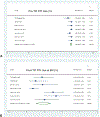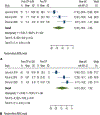Impact of second-generation transoral incisionless fundoplication on atypical GERD symptoms: a systematic review and meta-analysis
- PMID: 36402203
- PMCID: PMC10201409
- DOI: 10.1016/j.gie.2022.11.002
Impact of second-generation transoral incisionless fundoplication on atypical GERD symptoms: a systematic review and meta-analysis
Abstract
Background and aims: Transoral incisionless fundoplication (TIF) using the EsophyX device (EndoGastric Solutions, Inc, Redmond, Wash, USA) is a minimally invasive endoscopic fundoplication technique. Our study aimed to assess the efficacy of TIF for atypical GERD symptoms in patients with chronic or refractory GERD.
Methods: A systematic search of 4 major databases was performed. All original studies assessing atypical GERD using a validated symptom questionnaire (the reflux symptom index [RSI]) were included. The RSI score was assessed before and after TIF at a 6- and 12-month follow-up. Data on technical success rate, adverse events, proton pump inhibitor (PPI) use, and patient satisfaction were also collected. Only TIF procedures currently in practice using the EsophyX device (ie, TIF 2.0) and TIF with concomitant hiatal hernia repair were included in the review.
Results: Ten studies (564 patients) were included. At the 6- and 12- month follow-up, there was a mean reduction of 15.72 (95% confidence interval, 12.15-19.29) and 14.73 (95% confidence interval, 11.74-17.72) points, respectively, in the RSI score post-TIF, with a technical success rate of 99.5% and a pooled adverse event rate of 1%. At both time intervals, more than two-thirds of the patients were satisfied with their health condition and roughly three-fourths of the patients were off daily PPIs.
Conclusions: Our study shows that TIF using the EsophyX device is safe and effective in reducing atypical GERD symptoms at 6 and 12 months of follow-up. It improves patient-centered outcomes and can be a minimally invasive therapeutic option for patients suffering from atypical GERD symptoms on chronic medical therapy.
Copyright © 2023 American Society for Gastrointestinal Endoscopy. Published by Elsevier Inc. All rights reserved.
Conflict of interest statement
Conflict of Interest:
MH: None
JGB: None
UH: None
CB: None
PAB: None
PJ: has received research support from Apollo Endosurgery, Fractyl and GI Dynamics, has served as a consultant to Endogastric Solutions and GI Dynamics, has received an honorarium from Obalon Therapeutics, and has received in-kind support from USGI Medical.
CCT: is a consultant and received research support from Apollo Endosurgery, Boston Scientific, Fujifilm, GI Dynamics, Lumendi, Olympus, USGI Medical. Consultant for Medtronic and Fractyl. Institutional research grants from Aspire Bariatrics and ERBE. General partner for BlueFlame Healthcare. Founder/Consultant/Board Member for Envision Endoscopy, Enterasense and GI Windows.
Figures















Similar articles
-
Efficacy of transoral incisionless fundoplication (TIF) for the treatment of GERD: a systematic review with meta-analysis.Surg Endosc. 2017 Mar;31(3):1032-1044. doi: 10.1007/s00464-016-5111-7. Epub 2016 Aug 5. Surg Endosc. 2017. PMID: 27495332
-
Efficacy of Laparoscopic Nissen Fundoplication vs Transoral Incisionless Fundoplication or Proton Pump Inhibitors in Patients With Gastroesophageal Reflux Disease: A Systematic Review and Network Meta-analysis.Gastroenterology. 2018 Apr;154(5):1298-1308.e7. doi: 10.1053/j.gastro.2017.12.021. Epub 2018 Jan 3. Gastroenterology. 2018. PMID: 29305934
-
Impact of transoral incisionless fundoplication (TIF) on subjective and objective GERD indices: a systematic review of the published literature.Surg Endosc. 2013 Oct;27(10):3754-61. doi: 10.1007/s00464-013-2961-0. Epub 2013 May 4. Surg Endosc. 2013. PMID: 23644835
-
Concomitant hiatal hernia repair with transoral incisionless fundoplication for the treatment of refractory gastroesophageal reflux disease: a systematic review.Surg Endosc. 2024 Oct;38(10):5528-5540. doi: 10.1007/s00464-024-11201-2. Epub 2024 Sep 13. Surg Endosc. 2024. PMID: 39271515
-
Efficacy of different endoscopic treatments for gastroesophageal reflux disease: a systematic review and network meta-analysis.J Gastrointest Surg. 2024 Jul;28(7):1051-1061. doi: 10.1016/j.gassur.2024.04.020. Epub 2024 Apr 24. J Gastrointest Surg. 2024. PMID: 38670431
Cited by
-
Endoscopic full-thickness plication for the treatment of gastroesophageal reflux disease: A systematic review and meta-analysis.Endosc Int Open. 2024 Feb 12;12(2):E199-E210. doi: 10.1055/a-2231-7136. eCollection 2024 Feb. Endosc Int Open. 2024. PMID: 38390496 Free PMC article. Review.
-
New Developments in Anti-Reflux Surgery: Where Are We Now?Visc Med. 2024 Oct;40(5):250-255. doi: 10.1159/000538117. Epub 2024 Apr 9. Visc Med. 2024. PMID: 39398392 Review.
-
Endoscopic Management Options for Gastroesophageal Reflux Disease.Cureus. 2024 Jun 10;16(6):e62069. doi: 10.7759/cureus.62069. eCollection 2024 Jun. Cureus. 2024. PMID: 38989395 Free PMC article. Review.
-
Refractory Gastroesophageal Reflux Disease: Diagnosis and Management.J Neurogastroenterol Motil. 2024 Jan 30;30(1):17-28. doi: 10.5056/jnm23145. J Neurogastroenterol Motil. 2024. PMID: 38173155 Free PMC article. Review.
-
New Perspectives in Endoscopic Treatment of Gastroesophageal Reflux Disease.Diagnostics (Basel). 2023 Jun 14;13(12):2057. doi: 10.3390/diagnostics13122057. Diagnostics (Basel). 2023. PMID: 37370952 Free PMC article. Review.
References
-
- Koufman JA. The Otolaryngologic Manifestations of Gastroesophageal Reflux Disease (GERD): A Clinical Investigation of 225 Patients Using Ambulatory 24-Hour pH Monitoring and an Experimental Investigation of the Role of Acid and Pepsin in the Development of Laryngeal. Laryngoscope. 1991;101(4):1–78. doi:10.1002/lary.1991.101.s53.1 - DOI - PubMed
Publication types
MeSH terms
Substances
Grants and funding
LinkOut - more resources
Full Text Sources
Medical

